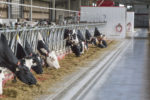Items Tagged with 'mastitis'
ARTICLES
Benchmarking antibiotic usage on the farm
Defined daily dose is the adopted measurement for antibiotic protocols and is the number of days an average cow received an antibiotic treatment in a time period.
Read More
Diagnosing and managing a leptospirosis crisis on a 500-cow dairy
A veterinarian describes the navigation and successful treatment of a leptospirosis crisis; highlighting the challenges, diagnostic breakthrough and importance of collaboration in addressing unforeseen herd health issues.
Read More
Optimizing fertility: Health impact of lactating cows under Double Ovsynch protocol
Transition cow health is a prerequisite for achieving high fertility in a Double Ovsynch protocol.
Read More
Back to the basics: Gram-negative vs. gram-positive mastitis
A review of the differences between gram-negative and gram-positive mastitis pathogens.
Read More
Progressive Events: ‘Every connection counts’ at the Global Dairy Experience
Technology, beef-on-dairy, mastitis, a banker's perspective and cybersecurity kept attendees at the Global Dairy Experience busy during the two-day event in Las Vegas.
Read More
Prototheca: A contagious mastitis risk you might be underestimating
Due to the nature of prototheca, it is not discussed as often as other mastitis pathogens. However, it is detrimental to a herd and should be treated appropriately.
Read More
A fresh look at using antibiotics to treat mastitis
Maintaining quality records, following protocol, managing mastitis and properly training employees are four ways to fine-tune your management and adjust to over-the-counter antibiotic changes implemented June 2023.
Read More
Unique herd of Holsteins could help reduce mastitis in dairy cows
Genetic data from a group of unselected Holsteins in Minnesota could provide insight into mastitis resistance in dairy cattle today.
Read More
Mycoplasma: Don't let it be a major problem
A mycoplasma outbreak can cause catastrophic results in a milking herd. Early detection, frequent and thorough sampling and an action plan can aid in preventing an outbreak.
Read More










